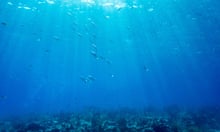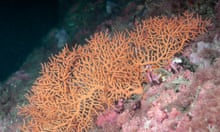Earth’s oceans are changing colour and climate breakdown is probably to blame, according to research.
The deep blue sea is actually becoming steadily greener over time, according to the study, with areas in the low latitudes near the equator especially affected.
“The reason we care about this is not because we care about the colour, but because the colour is a reflection of the changes in the state of the ecosystem,” said BB Cael, a scientist at the National Oceanography Centre in Southampton and author of the study published in Nature.
Prior research focused on changes in the greenness of the ocean – from the verdant chlorophyll in its plankton – to learn about trends in the changing climate. But Cael’s team pored over 20 years of observations by Nasa’s Modis-Aqua satellite, an exhaustive data repository, and looked for patterns of change in the ocean’s hue through a fuller colour spectrum including red and blue.
Plankton of different sizes scatter light differently, and plankton with different pigments absorb light differently. Examining changes in colour can give scientists a clearer picture of changes in plankton populations around the globe. Phytoplankton is crucial to ocean ecosystems because it is at the base of most of its food chains.
When comparing these changes in colour with those hypothesised from a computer model simulating what the oceans would look like if human-caused global heating had never taken place, the change was clear.
“We do have changes in the colour that are significantly emerging in almost all of the ocean of the tropics or subtropics,” said Cael.
The changes have been detected over 56% of the world’s oceans – an area greater than all of the land on Earth.
In most areas there’s a clear “greening effect”, Cael said, but he added that there are also places where red or blue colourings are rising or falling.
“These are not ultra, massive ecosystem-destroying changes, they may be subtle,” said Cael. “But this gives us an additional piece of evidence that human activity is likely affecting large parts of the global biosphere in a way that we haven’t been able to understand.”
Although this discovery firmly documents another consequence of a changing climate, what is not yet clear is how strong these changes are and what is happening inside the ocean to cause them, according to Michael J Behrenfeld, a researcher of ocean productivity at Oregon State University, who was not involved in the research.
“Most likely, the measured trends are associated with multiple factors changing in parallel,” said Behrenfeld. For instance, the potentially increasing abundance of microplastics in the ocean, which like any other particles increase light scattering.
after newsletter promotion
“With answers to these questions, we can then begin understanding what the ecological and biogeochemical implications are,” said Behrenfeld.
Nasa will be launching an advanced satellite mission in January 2024 called Pace (plankton, aerosol, cloud, ocean ecosystem) which will also measure hundreds of colours in the ocean instead of a handful, progressing studies like these further.
“Making more meaningful inferences about what the changes actually are ecologically is definitely a big next step,” said Cael.










